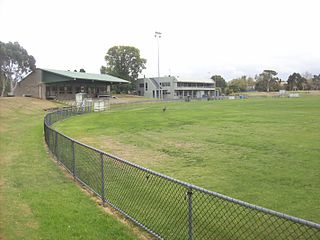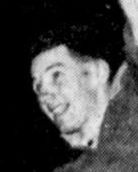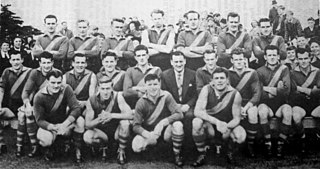Northcote Football Club (/ˈnoːθ.kət/), nicknamed The Dragons, was an Australian rules football club which played in the VFA from 1908 until 1987. The club's colours for most of its time in the VFA were green and yellow and it was based in the Melbourne suburb of Northcote.

Caulfield Football Club was an Australian rules football club which played in the VFA from 1965 until 1987 when due to financial difficulties the club folded.
Camberwell Football Club was an Australian rules football club which formed around the mid-1880s, with a published match in 1886 and competed in the Victorian Football Association (VFA) between 1926 and 1990. Nicknamed the Cobras, Camberwell wore blue, white and red club colours. They were based in the Melbourne suburb of Camberwell.

Elsternwick Park is an Australian rules football and cricket stadium in Brighton, a suburb of Melbourne in Victoria, Australia. The name also refers to the wider parkland in which the main oval is located. The ground is the administrative and primary central playing base of the Victorian Amateur Football Association.
Waverley Football Club, nicknamed the Panthers, were an Australian rules football club which played in the Victorian Football Association (VFA) from 1961 until 1987. Waverley wore red and black as their club colours and was based at Central Reserve in the Melbourne suburb of Glen Waverley.

Peter John Schofield is a former Australian rules footballer who played for Richmond, Melbourne, and North Melbourne in the Victorian Football League (VFL) during the 1950s.
Sunshine Football Club, nicknamed The Crows, was an Australian rules football club which played in the Victorian Football Association (VFA) from 1959 until 1989. The club colours were navy blue and white.
Moorabbin Football Club, nicknamed the Kangaroos, was the name of two distinct Australian rules football clubs which played in the Victorian Football Association (VFA). The first club, founded in the early 20th century, joined the VFA in 1951 and played there until 1963 with great success; they played home matches at Moorabbin Oval and wore royal blue and white hooped jerseys. The second club played in the VFA from 1983 to 1987.
Jim Gutterson was an Australian rules footballer who played with Footscray in the Victorian Football League (VFL).
The 1948 Victorian Football Association season was the 67th season of the Australian rules football competition. The premiership was won by the Brighton Football Club, which defeated Williamstown by nine points in the Grand Final on 9 October. It was the first and only Division 1 premiership won by the club in its time in the Association as either Brighton or Caulfield.

The 1954 Victorian Football Association season was the 73rd season of the Australian rules football competition. The premiership was won by the Williamstown Football Club, after it defeated Port Melbourne by 32 points in the Grand Final on 2 October. It was Williamstown's sixth premiership, and the first of five premierships won in six seasons from 1954 until 1959.
The 1958 Victorian Football Association season was the 77th season of the Australian rules football competition. The premiership was won by the Williamstown Football Club, after it defeated Moorabbin in the grand final replay on 4 October by 32 points. It was Williamstown's ninth premiership, drawing it level with Footscray for the most premierships won in VFA history, and it was the fourth of five premierships won in six seasons between 1954 and 1959.
The 1959 Victorian Football Association season was the 78th season of the Australian rules football competition. The premiership was won by the Williamstown Football Club after it defeated Coburg in the Grand Final on 10 October by 35 points. It was Williamstown's tenth premiership, taking it past Footscray to become the club with the most premierships won in VFA history, a title it held until it was passed by Port Melbourne in 1976; it was also the fifth of five premierships won in six seasons between 1954 and 1959, and the club's fourth consecutive minor premiership.
The 1960 Victorian Football Association season was the 79th season of the Australian rules football competition. The premiership was won by the Oakleigh Football Club, after it defeated Sandringham in the Grand Final on 1 October by 60 points. It was Oakleigh's fifth premiership.
The 1961 Victorian Football Association season was the 80th season of the Australian rules football competition. The season saw a significant change in the structure of the Association, with the competition split into two divisions, with promotion and relegation between them, a system which remained in place until 1988.
The 1962 Victorian Football Association season was the 81st season of the top division of the Australian rules football competition, and the second season of its second division. The Division 1 premiership was won by the Sandringham Football Club, after it came from behind to defeat Moorabbin in the Grand Final on 29 September by one point; it was Sandringham's second VFA premiership. The Division 2 premiership was won by Dandenong; it was the club's first premiership in either division.
The 1963 Victorian Football Association season was the 82nd season of the top division of the Australian rules football competition, and the third season of its second division. The Division 1 premiership was won by the Moorabbin Football Club, after it defeated Sandringham in the Grand Final on 21 September by 64 points; it was Moorabbin's second and last VFA premiership, before its suspension from the Association prior to the following season. The Division 2 premiership was won by Preston; it was the club's first premiership in either division since joining the Association.
The 1964 Victorian Football Association season was the 83rd season of the top division of the Australian rules football competition, and the fourth season of its second division. The Division 1 premiership was won by the Port Melbourne Football Club, after it defeated Williamstown in the Grand Final on 26 September by 36 points; it was Port Melbourne's 8th VFA premiership. The Division 2 premiership was won by Geelong West, in only its second season in the VFA.
The 1965 Victorian Football Association season was the 84th season of the top division of the Australian rules football competition, and the fifth season of its second division. The Division 1 premiership was won by the Waverley Football Club, after it defeated Port Melbourne in the Grand Final on 26 September by twelve points; it was the first and only premiership ever won by Waverley in either division in its time in the Association, and it came in only its second season in Division 1. The Division 2 premiership was won by Preston; it was the club's second Division 2 premiership in three years, having competed in and been relegated from Division 1 in the intervening year.




